How to enable Javascript
The following instructions describe how to set JavaScript options for: Firefox, Mozilla, Opera, Safari, Explorer, Netscape, and AOL browsers.
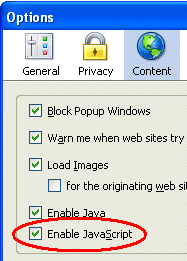
Firefox 1.X
- Open Firefox.
- Select Options from the Tools menu.
- Click Content.
- Click Enable Javascript.
- Click OK.
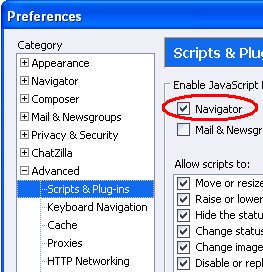
Mozilla 1.X
- Open Mozilla.
- Select Preferences from the Edit menu.
- Click the arrow next to Advanced.
- Click Scripts & Plugins.
- Check Navigator beneath "Enable Javascript for".
- Click OK.
- Click Reload.
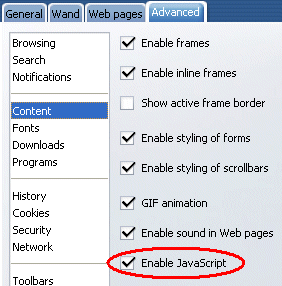
Opera 5.X
- Open Opera.
- Select Quick Preferences from the File menu.
- Make sure Enable Javascript is checked.
- Click Reload.
Opera 7.X
- Open Opera.
- Select Quick Preferences from the File menu.
- Make sure Enable Javascript is checked.
- Click Reload.
The same affect can be achieved through Preferences, Advanced.
Safari Public Beta 2 for MACOSX
- Open Safari.
- Select Preferences from the Safari menu.
- Click Security.
- Check Enable JavaScript.
- Close the window.
- Click Reload.
Internet Explorer 3.X
- Select Options from the View menu.
- Click Security.
- Check Enable Java Programs.
- Click OK.
- Click Reload.
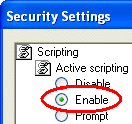
Internet Explorer 4.X
- Select Internet Options from the View menu.
- Click the Security tab.
- Click Custom.
- Click Settings.
- Scroll down to locate Scripting.
- Click Enable for Active Scripting.
- Click OK.
- Click Reload.

Internet Explorer 5.X
- Open Internet Explorer.
- Select Internet Options from the Tools menu.
- In Internet Options dialog box select the Security tab.
- Click Custom level button at bottom. The Security Settings dialog box will pop up.
- Under Scripting category enable Active Scripting
- Click OK twice to close out.
- Hit Refresh.
Internet Explorer 5.X for MACOSX
- Open Internet Explorer.
- Select Preferences from the Explorer menu.
- Click the arrow next to Web Browser.
- Click Web Content.
- Under Active Content check Enable Scripting.
- Click OK.
- Click Refresh.
Internet Explorer 5 for MACOS9
- Open Internet Explorer.
- Select Preferences from the Edit menu.
- Click the arrow next to Web Browser.
- Click Web Content.
- Under Active Content check Enable Scripting.
- Click OK.
- Click Refresh.

Internet Explorer 6.X
- Open Internet Explorer.
- Select Internet Options from the Tools menu.
- In Internet Options dialog box select the Security tab.
- Click Custom level button at bottom. The Security settings dialog box will pop up.
- Under Scripting category enable Active Scripting
- Click OK twice to close out.
- Click Refresh.

Netscape 4.X
- Open Netscape.
- Select Preferences from the Edit menu.
- Click Advanced.
- Check Enable JavaScript
- Click OK.
- Click Reload.
Netscape 4.X for MACOS9
- Open Netscape.
- Select Preferences from the Edit menu.
- Click Advanced.
- Check Enable JavaScript
- Click OK.
- Click Reload.
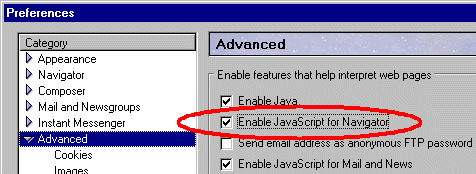
Netscape 6.X for MACOSX
- Open Netscape.
- Select Preferences from the Edit menu.
- Click Advanced
- Check Enable JavaScript for Navigator
- Click OK.
- Click Reload.
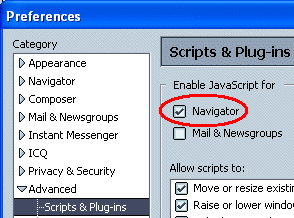
Netscape 7.X
- Open Netscape.
- Select Preferences from the Edit menu.
- Click the arrow next to Advanced.
- Click Scripts & Plugins.
- Check Navigator beneath "Enable Javascript for".
- Click OK.
- Click Reload.
AOL 4.0 and 5.0
- Click My AOL.
- Click Preferences.
- Click WWW.
- Click the Security tab.
- Click Custom.
- Click Settings.
- Scroll down to locate Scripting.
- Click Enable for Active Scripting.
- Click OK, then click the Reload button.
Note to AOL 4.0 & 5.0 users
When using the use AOL browser, you may get a Javascript error but, when using an external browser (i.e., Netscape or Internet Explorer) this does not occur. AOL uses compressed graphics by Default. This doesn't allow Java to work while browsing inside AOL. (Additionally, this makes photos you view on web pages look less than optimal.) Do the following:
- Click My AOL.
- Click Preferences.
- Click the WWW icon.
- Click Web Graphics tab.
- Uncheck the box next to Use Compressed Graphics.
- Click OK Restart the computer.
Note that there are both 16-bit and 32-bit versions of AOL 4.0. Only the 32-bit version has full Java capabilities.